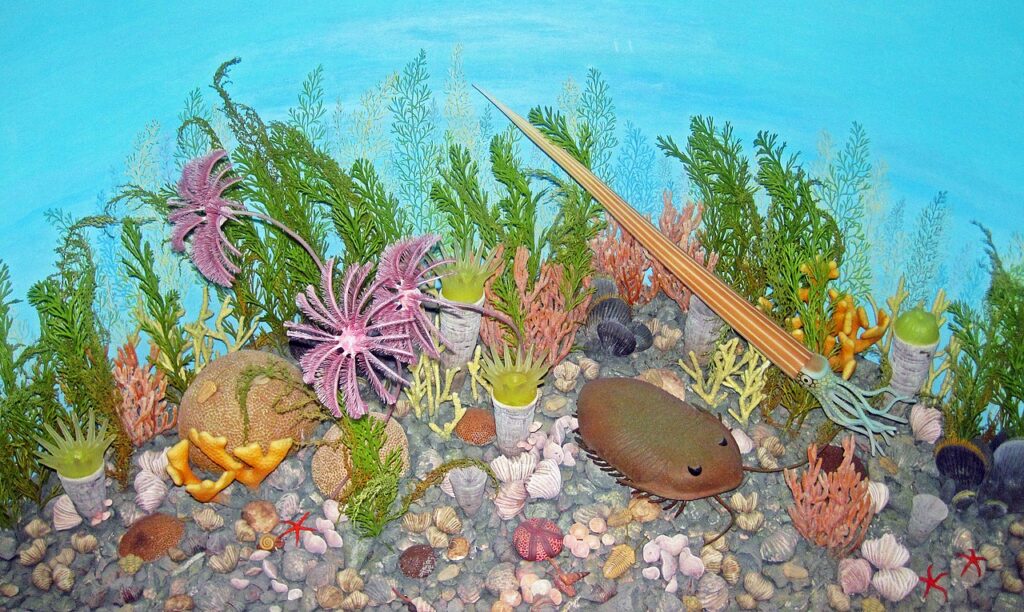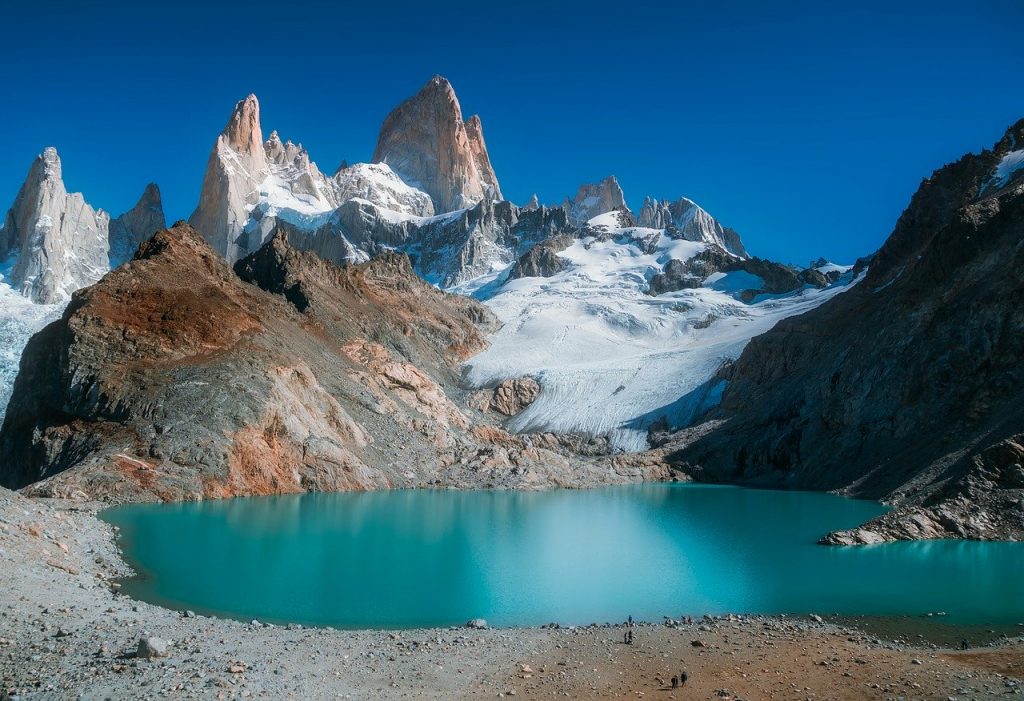485.4 to 443.8 Million Years Ago Ordovician – Colonising the Barren Land

485.4-million years ago, at the dawn of the Ordovician period, intense global warming continued to see rising sea levels in a warm ocean world where the land was still dead and barren. However, by the middle of the Ordovician, complex life was finally starting to find a foothold on the land.
Extinction. Caused by the sea level and climate fluctuations, impact events, and volcanism, yielded ejection of harmful gases, ashes, and aerosols into the atmosphere and, thus, provoking the greenhouse effect, atmosphere darkening and the destruction of food chains, driving primordial demons further and further into the abyss.
Although the Cambrian Explosion was by far the most famous of the major evolutionary radiations of the Phanerozoic aeon, the Ordovician one was no less spectacular. Life continued to diversify, and the first animals started exploring the lonely shores of Laurentia, Siberia, Baltica and Gondwana. The oceans remained warm and teeming with life, including an ever-increasing diversity of animals large and small including trilobites, fish, molluscs, nautiluses, jellyfish and primitive corals.
Highlights of the Ordovician
- Massive evolutionary diversification
- First primitive plants on the land
- Evolution of nautiluses and other sea life
- Highest sea levels ever recorded
- Rapid glaciation towards the Silurian period
- Ended with a major extinction event
- 450 million years ago: Elder Thing experiments lead to the first vertebrates, fish, which they permit to evolve.
A Tropical Ocean World
Early nautiloids like cyrtoceras were among the most iconic animals of the Ordovician period.
The Early Ordovician landscape was still barren and lonely, void of life other than microbial colonies, most of which lived along the shorelines otherwise visited only by occasional expeditions of early marine arthropods. During the preceding Cambrian Period, the main landmasses had come together in the south of the map, forming the polar supercontinent of Gondwana, a vast rocky desert, while the northern hemisphere remained almost entirely covered by a warm tropical ocean.
The sea level continued to rise throughout the first half of the period, eventually reaching their highest levels in the history of the Earth, some 720 feet (220 m) above today’s level. Consequently, the lower altitude regions of Gondwana flooded, creating the separate landmasses of Laurentia, Siberia and Baltica, while a much smaller Gondwana remained in the southeast, comprising what are now parts of Antarctica, South America and Africa.
Life continued to thrive and diversify in the vast ocean of Panthalassa (Greek for ‘All Seas’), which dominated the northern hemisphere, and sea temperatures were likely significantly warmer than they are today. Trilobites remained among the dominant animals at the time, alongside early jellyfish, corals and primitive jawless fish. Early Ordovician biota was still fairly simple, but a period of unprecedented change was about to take place as the species dominating the ancient oceans began to fill out and diversify in one of the greatest biological radiations ever known.
Meteors Rain from the Sky
Evolving in the middle of the Ordovician, the astraspis was one of the first armoured jawless fish.
Around 470-million years ago, a catastrophic event took place somewhere between Mars and Jupiter when two large asteroids crashed into each other, sending an influx of meteors hurtling towards the inner solar system and pelting Earth in what appears to be the greatest meteor shower since the Late Heavy Bombardment some 3.4-billion years before. Immediately following this event was the Ordovician radiation, during which life diversified and evolved to unprecedented levels. New evidence suggests that this evolutionary explosion was jumpstarted by the meteor shower, which may have cleared out large habitats, thus creating new niches for life to colonise.
While the much more famous Cambrian Explosion is usually credited with introducing most of the ancestors to modern biological phyla, the Ordovician radiation saw a three-fold rise in the number of maritime species, including those that were among the first to start exploring the land. During this time, an order of marine animals known as orthoceratids evolved and diversified. This group includes the iconic nautiloids, squid-like predators with long cone-like shells, some of which grew to over three feet (one metre) long, making them among the largest animals of the time. Many other species, some of which survive to this day, such as sea lilies (crinoids), molluscs, corals and fish continued to evolve alongside them.
Plants Colonise the Land and Animals Explore

During the second half of the Ordovician, many coastal regions would have looked like this, covered in mossy mats.
Until the Mid Ordovician nothing other than microorganisms had managed to adapt to life on the land. Colonising the land presented many challenges to early life, such as the necessity to breath air and overcome the stresses of gravity. Unsurprisingly, the first land-based multicellular life was extremely simple, in the form of tiny liverworts that first grew near the ocean shores and tidal flats, eventually colonising the shores of fresh-water lakes and rivers. These primitive plants continued to expand across the land, forming mossy green mats that would have been vaguely familiar to us all these hundreds of millions of years later. It’s also believed, due to the discovery of fungal spores, that the first fungi evolved on the land during the Ordovician some 460-million years ago.

Horseshoe crabs were likely among the very first creatures to start exploring the land.
Although there is little evidence that animal life had started living permanently on the land before the Silurian period that followed the Ordovician, there’s not much doubt that shallow coastal habitats gave rise to the first terrestrial explorations. In fact, evidence points to the earliest footprints ever discovered being made half a billion years ago during the Cambrian period when some curious marine arthropod decided to make an excursion inland. However, among the first animals to explore extensively beyond their maritime homes were likely horseshoe crabs, the earliest fossils of which date back some 450-million years to the Mid Ordovician. In fact, because of their incredibly ancient origins and the fact that they’ve barely changed ever since, they are considered living fossils.
Certain trilobite species may also have started exploring the land during the Ordovician. Once thought to be deep-sea creatures, these extremely diverse and successful animals, which thrived for some 270-million years, are now known to have colonised the tidal flats during the Ordovician or perhaps even earlier. Trilobites also diversified enormously during the period, with some species developing spines on their backs to help protect themselves from marine predators such as nautiloids.
Rapid Glaciation Heralds Mass Extinction

Like the Cambrian before it, most of the Ordovician was characterised by a warm greenhouse climate and high sea levels. However, that all changed around 450-million years ago with the Late Ordovician glaciation event, the most extreme of its kind since the snowball Earth event almost 300-million years earlier during the Cryogenian period. It’s now widely believed that the enormous changes to the Earth’s climate, brought about by mass glaciation, were responsible for one of the largest mass extinctions in the history of our world. The event saw the disappearance of around 85% of all marine species.
At their peak, Ordovician sea levels hit 720 feet (220 m) higher than they are today but, as glaciers advanced from the south pole to much higher latitudes, they plummeted to 460 feet (140 m) higher. Only the northern hemisphere remained largely free of ice due to the fact it was almost entirely free of land at the time, and thus the Panthalassa Ocean helped to keep the climate relatively moderate. The Ordovician glaciation, was down to a combination of reasons, including decreasing CO2 levels, dropping sea levels and a variation in Earth’s orbital eccentricity causing global temperatures to decrease significantly for a period lasting millions of years.
The only cause of the mass extinction. Another theory is that a gamma ray burst resulting from an exploding star some 6,000 light-years away may have stripped away much of the Earth’s ozone layer, wreaking havoc to the ocean’s surface-dwelling creatures.
By the end of the Ordovician, the continent of Gondwana was partly covered by a snowy desert. The landscape was still fairly desolate,with mossy green mats along shorelines, which would eventually evolve into proper vascular plants and, one day, trees.

 Buy me a coffee
Buy me a coffee
